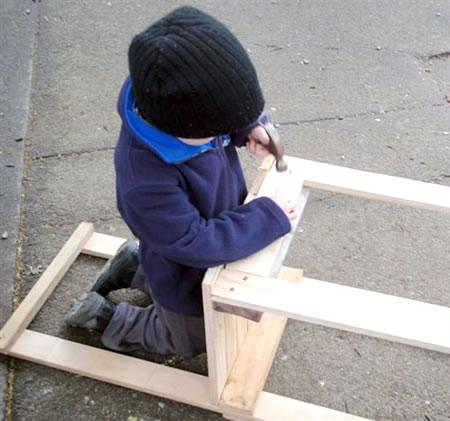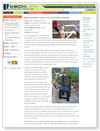Making outdoor chairs from recyclable materials
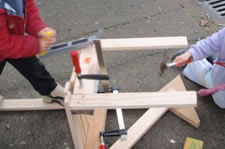
Class: Early Childhood Education
Teacher: Sue Barrett, Chris Booth, Lorna Tawhiti, and Pene Ryan
Early Childhood Centre: Otaki Kindergarten
Duration: Two weeks
Otaki Kindergarten had a problem with their outdoor chairs. The donated chairs had fabric cushions and had to be taken out and brought back inside every day. With little money in the budget for new furniture, the class decided to create their own chairs using recycled and donated materials that could be left permanently outside.
Initial inspiration for the design came from a website that made furniture from recycled wooden pallets. After researching all the varieties of chair designs on the site, the group decided on one they all liked then got to work finding suitable pieces of wood around them on the kindergarten grounds that would provide their basic materials. The group agreed that when the chairs became too old to use, the wood could be reused as firewood once the nails were removed. The nails, if still usable, would be put aside for use in a replacement chair.
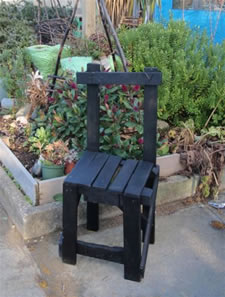 To get an idea of the lengths of wood needed, the existing chairs were measured and used as a reference throughout. Selected pieces of wood were then sawn to the right sizes and nailed together over several days.
To get an idea of the lengths of wood needed, the existing chairs were measured and used as a reference throughout. Selected pieces of wood were then sawn to the right sizes and nailed together over several days.
Intrigued by what the children were doing, a local fencer provided them with an old rasp and taught them how to use it. The kids were quick to put their new skills into action, removing the rough edges of the finished first prototype. While it looked good, the class realised it was far too wobbly to use and it was dismantled and the parts made ready for a second attempt.
A drill and screws were used as well as the nails for the second prototype, greatly improving the stability of the chair but also creating other problems. The drill required more force and weight than the four year olds could provide. A local parent helped out here by donating G-clamps to hold the wood firm while drilling, and teaching the class how to make pilot holes, which made the screws far easier to put in and remove later.
With the end almost in sight, the children ran out of materials and couldn't fasten the top bar of the chair in place. Thanks to a little lateral thinking by one of the children, flax was used to tie on the final piece temporarily. Sue then brought out some old tins of black and pink paint and the class got to work putting the finishing touches on their first working chair.
With the group actively involved in the problem-solving and construction of the first successful prototype, it was pretty smooth sailing for them to make the next two. With a new skills set developed the class is now ready for the next project.
Teacher Comment
The following summary of outcomes and reflections is taken from the original term book entry (PDF, 28kb).
We all learnt a lot from this exercise.
There were all the physical skills associated with carpentry. The hand-eye co-ordination, the development and strengthening of muscles, small and large.
There was communication of all sorts, and great opportunities for sharing and turn-taking.
The principle of tuakana/teina cropped up often as the more accomplished children demonstrated, advised and helped others who then took their turn as tuakana.
We needed to plan and measure and think about how things could be put together.
There was always perseverance and patience.
Tools had to be used appropriately and carefully. They had to be respected and taken care of.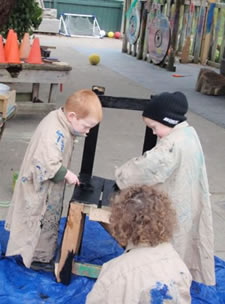
It was important to have the right resources. Nails and screws that were the right length – a selection of timber that allowed choice.
Children preferred the adult sized hammers and saws. Although heavier, they did cope well with them.
There were often problems that needed to be understood and overcome.
We needed 'knowledgeable others'. Children and whanau who shared their expertise.
Re-cycling materials was an underlying principle.
This exercise was sustained by the shared interest of tamariki and kaiako. It is curriculum mahi that is driven by a need. It combines all the elements of successful curriculum.
It attracted the children who love to construct, the children who love to be involved in kaiako associated mahi, those who love a project and those who loved to use the tools involved – the battery drill, g-clamps, and saws.
The concepts of what makes a chair into a chair were explored.Reinforcing Otaki Kindergarten's values and philosophy
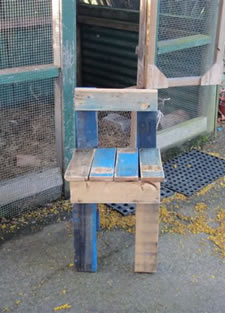 The thinking behind this project reinforces some of the basic principles of sustainability that underlie Otaki Kindergarten's philosophy, while showing a concrete link between classroom practice and practical need.
The thinking behind this project reinforces some of the basic principles of sustainability that underlie Otaki Kindergarten's philosophy, while showing a concrete link between classroom practice and practical need.
Otaki Kindergarten is a sessional Early Childhood Centre servicing 85 families within the Otaki area from Manakau down to Te Horo.
Teacher Sue Barrett believes that the great strength of Otaki Kindergarten lies in their philosophy of "enhancing the mana of children and whanau with a strong focus on sustainable-environmental education", which was developed in keeping with ECE curriculum guidelines to "build respectful relationships with people, places, living things, and things".
Adhering to this philosophy led Otaki Kindergarten to become part of the Ministry of Education's Centre of Innovation project, established in 2003 to promote Early Childhood Education services that exemplify "effective approaches and innovative practice to improve teaching and learning processes and support the effective implementation of Te Whāriki, the Early Childhood Curriculum".
This Teacher Snapshot gives an example of the above concepts being put into action through good Technological Practice in the construction of new outdoor furniture for the kindergarten.
